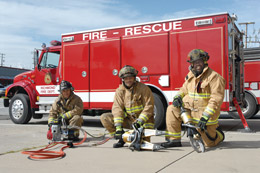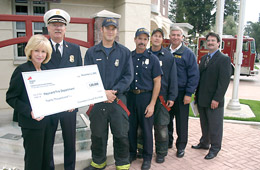Fireman's Fund lives up to its name
Agency employees on the "Bucket Brigade" serve on the front line of donations
By Phil Zinkewicz
Most people outside the insurance industry are not aware that Fireman’s Fund Insurance Company got its name from its founders in 1883, the name clearly identifying its mission to donate a portion of its profits to the widows and orphans of San Francisco volunteer firefighters. Over the years, with that mission still uppermost in its mind, but with a view towards a more proactive approach, Fireman’s Fund has contributed huge sums of money to fire stations and fire prevention units all over the country in order to reduce the number of firefighters’ widows and orphans.
Four years ago, the company decided to formalize the process by which donations were to be made to fire houses and fire prevention units, and its Heritage program was born. Simply stated, Heritage is a national community-based program that provides needed equipment, fire prevention tools and firefighter training for local fire departments, as well as community fire safety education.
“Today’s firefighters don’t just put out fires as in past days,” says Joseph J. Beneducci, president and CEO of Fireman’s Fund. “They must be ready to respond to many different situations such as medical emergencies, hazardous material accidents, wildfires and terrorist attacks. Chances are, if there is an emergency of any type, firefighters will be there, often first on the scene. However, due to budget constraints, our fire safety personnel are often asked to provide more services with fewer resources.”
Beneducci offered the following statistics:
• One in four fire department personnel involved in delivering emergency medical services lacks formal training.
• Three in four fire departments must raise or seek funds to cover some or all of their expenses.
• One in three firefighters on any given shift will not have the proper equipment needed to enter a smoke-filled building.
Beneducci says that there is no one way to solve all problems facing the nation’s fire services. “Each department has different needs that are specific to its community,” he says. “The Heritage Rewards program empowers Fireman’s Fund agents to direct grants to their local fire departments. Agents earn points, based on their business relationship with Fireman’s Fund, which can be redeemed for programs and equipment to meet the needs of local fire departments.”
The “Bucket Brigade” is designed for Firemen’s Fund employees and the employees of Fireman’s Fund agents, according to Beneducci. “Encouraging participation at the grassroots level, the Bucket Brigade allows employees to volunteer to support local fire departments, to nominate fire departments for grants and to review fire department grant applications for funding.
“We select certain communities around the country to create large-scale grant programs for fire departments and related community organizations,” Beneducci continues. “Communities are chosen based on demonstrated firefighting need, as well as on where Fireman’s Fund employees, agents and customers live and work. In 2004, Fireman’s Fund created large-scale grant programs in San Diego, Atlanta and the San Francisco Bay Area.”
In addition, Beneducci says that Fireman’s Fund partners with national firefighting organizations, including the International Association of Fire Chiefs, to help fund the National Fire Fighter Near-Miss Reporting System, and with the National Volunteer Fire Council to provide funding for the NVFC HeartHealthy Firefighter Program.
The types of firefighters’ apparel and equipment contributed by Fireman’s Fund include: turnout gear, which is protective clothing; fire shelters, used primarily for wildfires; self-contained breathing apparatus, primarily for entering smoke-filled buildings; communications equipment, so firefighters can communicate to each other during a fire; thermal imaging cameras, to help firefighters see through smoke, darkness and dense vegetation and brush; extrication equipment; and fire helicopters.
“The Heritage program is one that we’re building on every day,” says Beneducci. “We started the program in 2004, and by 2006 we had crossed the $10 million mark in terms of donations. In 2006, we had 160 actual redemptions on the part of our agents and employees. That was for the entire year. In the early part of this year, we had already passed the 200 mark in terms of redemptions.
“I am very proud of our screening process,” continues Beneducci, whose father was a career New York City firefighter. “We’re not just throwing money at a particular cause. We do our homework. We want to assist fire departments in obtaining the equipment they need. This is a social mission that goes back to our very roots.”
Beneducci traced the history of the Heritage program. “Early on, we began building a momentum for the program by offering general corporate grants to fire departments for fire safety. Then, we found it more effective to go through our agents and employees. Under our Bucket Brigade program, our employees must be certified to recommend a local fire house for a grant. Then we have a special panel, which includes fire services representatives, to make the final decision. If approved, the employee is actually authorized to write the check, with his or her own name at the bottom.”
In addition to Fireman’s Fund employees, some 800 agents currently are involved in Heritage. “We recently had a meeting of our top 100 agents,” says Beneducci, “and fully 50% had made redemptions. The other 50% were encouraged to jump onto the bandwagon.”
Finally, Beneducci says that Fireman’s Fund is dedicated to “telling the real story” about firefighters, not “the Hollywood version.” Adds Beneducci: “We wanted to depict what a firefighter faces day and day out. So, we financed a documentary, written and directed by an award-winning director. Titled ‘Into the Fire,’ we own the rights to the DVDs, which are available to fire houses.” (For a review of the documentary, see accompanying article.) “They can offer screenings, charge admission and use the funds to purchase equipment they need. In addition, we are producing media kits for fire houses and we have a few other ideas up our sleeves I can’t mention right now.”
Fund-raising is of paramount importance to fire houses, says Beneducci. “Funding challenges have left many volunteer and paid fire departments without adequate resources. It has been estimated that 78% of fire departments must raise or seek funds to cover some or all of their expenses. One-third of firefighters on any given shift will not have access to a self-contained breathing apparatus, which is needed to enter smoke-filled buildings. An estimated 792,000 firefighters serve in fire departments without programs to maintain basic firefighter fitness and health.
“Fireman’s Fund is committed to changing those statistics for the better,” continues Beneducci. “It is an emotional commitment. It’s part of our mission—part of our heritage.” *
|
Into the fire
In the Fireman’s Fund highly acclaimed documentary “Into the Fire,” which is part of the insurer’s Heritage program, a firefighter shares an experience with an off-camera interviewer:
There is a serious fire, and a building collapses. One of the firefighters is told that a woman’s voice can be heard from beneath the rubble. He approaches the collapsed building and, sure enough, there’s someone down there. He goes to his captain, who is still working his other men to get control of the fire and tells him about the trapped woman. The captain assesses the situation and says that he cannot, in good conscience, order any of his men to enter the collapsed building. The firefighter says he’d like to “take a shot at it.” The captain tells the firefighter that it’s his call, and the firefighter goes in.
Cut to the chase. The firefighter cuts his way through the collapsed building with an electric saw (actually, he goes through two electric saws) and saves the woman. Paramedics are taking her to the hospital, but she refuses to leave with the ambulance until she obtains the name of the firefighter who saved her life. She wants to thank him. The next day, the firefighter is written up in The New York Times, in a front page story, with a photo of him—looking heroic. Everyone is happy, except the firefighter’s wife. “Everybody thinks you’re wonderful. All I know is that I spent the entire night wondering if you were ever again coming home.”
Here, the firefighter just smiles wistfully and looks away from the camera.
This story and other stories related by firefighters all over the country are the heart of the Fireman’s Fund documentary, written and directed by Academy Award winner Bill Couturie. With background music by such notables as Bruce Springsteen and Bob Dylan, “Into the Fire” gives the viewer an opportunity to hear these stories from the men who lived them. You almost get the feeling that you’re chatting with them at the local firehouse.
Some of the stories are funny. One tells of a woman, confined to a wheelchair, who called the local fire department because her pet goose was lying on the ground prostrate as the result of a very hot day. One of the firefighters picked up the goose and brought it to a nearby shed to get it out of the sun.
“We received a very nice letter from the woman informing us that the goose eventually died, but that she was grateful for the help we gave. Laughing, the firefighter relating the story added: “She took a parting shot at us, though. At the bottom of the letter, she wrote that on the television show, ‘ER,’ they save all the animals.”
Of course, as one would expect, there are numerous scenes of actual fires and even a shot of the collapsing World Trade Center. One of the points driven home in the documentary is that fire houses across the country are often understaffed and lack the proper safety equipment to fight fires. For example, few fire houses have thermal imaging cameras, which allow firefighters to see through smoke and darkness. Firefighters from one fire house actually participated in a Lotto commercial singing off-key “If I Had a Million Dollars.” The proceeds from that commercial went to pay for a thermal imaging camera for their fire house. “Taxpayers didn’t have to pay anything,” says one firefighter.
The documentary is moving, amusing, gripping and well worth seeing. The actual film runs only an hour, but there are “bonus scenes” and other special features.
It is important to note that Fireman’s Fund is not profiting from this film. Any profits from sales of the DVD will go to support firefighters across the country. For more information about the film, go to http://www.firemansfund.com/
dcmsSites/heritage/html/itf_index.html. |
For more information:
Web site: www.firemansfund.com/heritage |
|
Click on image for enlargement |
 |
| |
Firefighters from the Richmond, California Fire Department display some of the new extrication equipment purchased through grants from Fireman’s Fund’s Heritage program. |
|
| |
 |
| |
Cheryl Downey, Senior Vice President of HRH Insurance Services of California, Inc., in Concord, and Jeff Lucia, Fireman’s Fund Business Development Manager (at far right) present the Hayward, California Fire Department with a $20,000 grant. |
|


